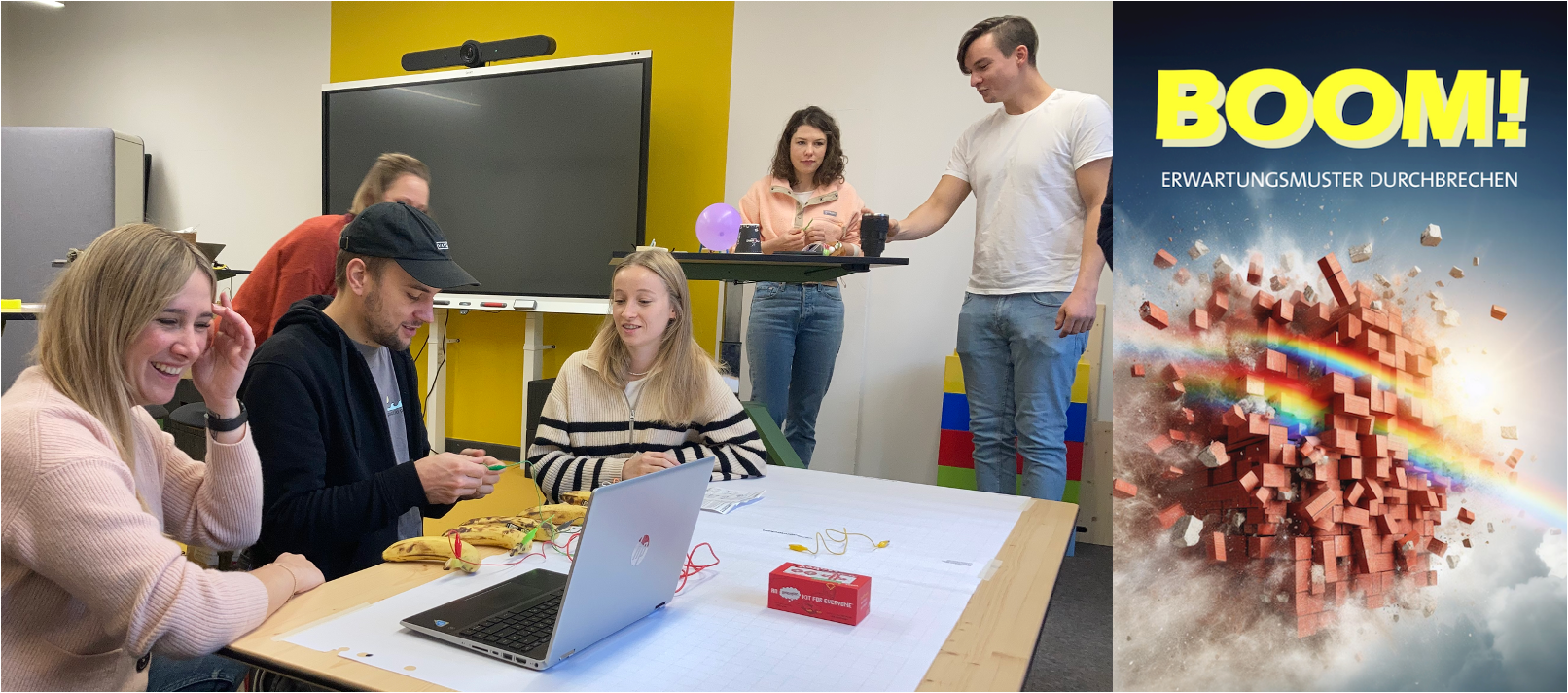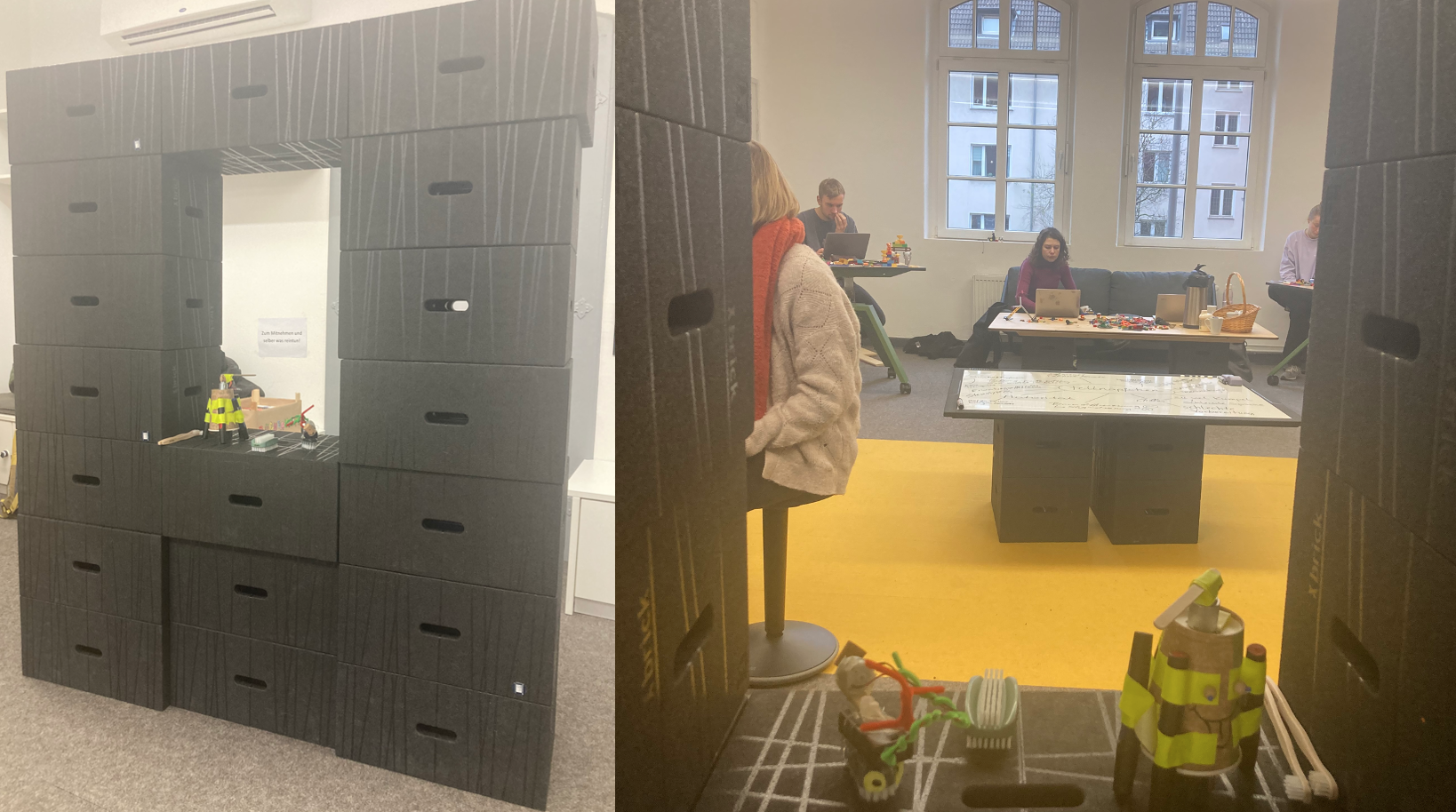BOOM! A Student-Centered Book Sprint with EdTechBooks

“Breaking Patterns” was the guiding perspective of a seminar co-facilitated by Thilo Harth and Stefanie Panke in the Master’s program for Vocational Education and Training (VET) at FH Münster (Germany). The seminar used the agile method of Booksprint. Eight participants experimented with digital tools such as E-Books, Podcasts, H5P, interactive visualizations, and generative AI. The writing process was interspersed with creative activities such as serious play, design thinking, and making.
The seminar comprised two workshop days and four 90-minute hybrid preparation sessions. The pre-workshop sessions were used to introduce digital tools, collectively decide on a central theme for the book, generate a cover using AI, and select the best design among the student proposals. In addition, students developed chapter proposals to work on during the two in-person workshop days and collected material and ideas for their topics.
The workshop took place on December 1st and 2nd in a room with innovative and flexible furniture, a ‘Makerspace for Teachers’. To start, we re-arranged some of the seating elements in the room to mirror the book cover, setting the tone for the seminar’s creative and constructive approach.

Day 1
We used Lego Serious Play for personal introductions. The LEGO models depicted for example a whale in the forest as a symbol for the unexpected, included a net to catch mistakes, and used movable elements to demonstrate energy, tension, and flexibility.
Then, the work began. Everyone was invited to review the text fragments or other prepared products and organize them into a structure to create a workable plan for the next two days. The work was coordinated in editorial meetings. Dealing with openness became a topic for the editorial discussions. Are the professors the gatekeepers? No. Are we all the editorial team? Yes. Should I refer to A or B? Your choice.
We ended the first day with proofreading, recording podcasts, and more editorial planning. Not everything went smoothly. One team experienced a setback of lost editing changes so that work had to be re-written. Others struggled with learning new tools and editing techniques. Still, everyone remained motivated and eager to achieve a completed product.
“I really appreciated the variety between the working phases, then a new tool was introduced followed by a break. I didn’t even realize how quickly time flew by. That we all motivated each other at the end to reach a certain point to continue with tomorrow. I am feeling positive!”
“We got through quite well. It was a bit chaotic at the beginning, trying to figure out where we stand and then building our own structure. We’re about halfway through. I think we’ll bring it to a fitting finale tomorrow.”
“I’m still a bit in the discovery phase. I would have liked a bit more output for this evening, but I’m quite confident that it will look better tomorrow, and at least the technical questions are initially resolved.”
“Not frustrated anymore, but you can tell that the brain is working really hard. Exhausted from everything that has been absorbed, having learned many new things.”
Day 2
The second day started in a rearranged room with four craft stations with different Maker-Sets and a large presentation table.
The stations included Makey-Makey, an invention kit that turns everyday objects into touch-sensitive keys, and projects like Doodle-Bot and Brush-Bot, encouraging creativity and understanding of robotics and mechanics. The maker station resulted in a cheerful group atmosphere and led to interdisciplinary scenarios for teaching at vocational schools.

“Very, very cool. A really great idea for starting a topic. Honestly, at first, I was scared that I couldn’t manage when I saw all the cables. But it was totally accessible”.
“Super exciting. Makey-Makey is definitely on my Christmas list!”.
“I just uploaded the Maker activity to my WhatsApp status because it just looks so fun and creative. I believe that kids can really be engaged with such tools. This morning, we heard so many ideas for using them in various lessons and subjects. It’s just amazing how many possibilities for variation there are”.
After an editorial meeting, task allocation, and lunch break, some participants had more work than others, offering an opportunity for collaboration across chapters. Students who were further along generated images, or researched sound effects for podcasts.
All participants contributed ideas for the final chapter to a whiteboard, and then one student took the lead in creating a first draft that was finalized with input from others who had finished their chapter. Similarly, students self-organized which chapter fragments needed to be deleted.
Around 2:30 PM, the collective work neared completion, leading to the last joint impulse: a quick design thinking process on ‘surprising ideas for vocational education’ through problem definition, idea generation, feedback, iteration, and prototype development. After presenting prototypes and reflecting on both process and results for future teaching settings, the seminar ended for the students. The organizers spent another two hours on final touches, but the book was indeed finished in two days.
In the concluding chapter, the students reflect on the value of spontaneity.
“What we have learned is spontaneity: allowing learners to create a podcast spontaneously, challenging them in a maker exercise spontaneously, switching to a digital tool spontaneously. This is an experience that has shown new potential for teaching. Another learning effect lies in creating interdisciplinary connections, which can break expectation patterns (including those of teachers). An example here is the activity with the Makey-Makey set, where the electrical voltage gradient is generated from the water content of bananas and can be used for both nutrition and home economics as well as electrical engineering classes”.
The final publishing process was quick and easy. Within one day, we heard back from Royce Kimmons, Associate Professor for Instructional Psychology & Technology at Brigham Young University and initiator of EdTechBooks. The Book Sprint result “BOOM! Erwartungsmuster durchbrechen“is available with an AI-generated English translation of the first three chapters and a German text-to-speech version of the first chapter.
The student authors see their book as a treasure trove of suggestions and unusual tips for lesson planning. Vocational school teachers can break patterns and find the courage to question the procedure as usual.
